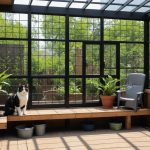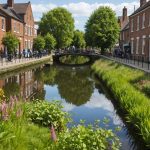Importance of Urban Green Spaces for Amphibians
Urban green spaces play a crucial role in supporting biodiversity, particularly for amphibian ecosystems. These areas act as essential habitats that provide food, breeding sites, and shelter, promoting the survival of amphibian populations. The presence of urban green spaces in cities helps mitigate the impact of urbanisation on wildlife by creating pockets of nature amidst concrete landscapes.
Amphibians are vital components of urban ecology, functioning as indicators of environmental health. They help control insect populations and contribute to nutrient cycling and energy flow within ecosystems. Their sensitivity to changes in the environment makes them excellent bioindicators, reflecting the overall health of the urban ecosystem.
In the same genre : Boosting uk farming: eco-friendly strategies to safeguard barn owl populations
Preserving amphibian populations within urban green spaces enhances biodiversity, benefiting not just amphibians but other organisms as well. Their presence supports a balanced ecosystem where different species can thrive. In urban settings, maintaining diverse amphibian communities contributes to ecological resilience, enabling ecosystems to better withstand disturbances and adapt to changes.
Furthermore, urban green spaces offer educational opportunities, allowing residents to observe and learn about local biodiversity. They encourage community involvement in conservation efforts, fostering a deeper connection between people and nature. By valuing and preserving these spaces, we ensure the continued biodiversity enhancement that is crucial for thriving urban ecosystems.
In the same genre : Transforming urban landscapes: how uk canal restoration initiatives boost biodiversity
Best Practices for Designing Amphibian-Friendly Habitats
Designing habitats that foster amphibian conservation within urban areas involves a blend of creativity and ecological understanding. The discipline of urban ecology focuses on creating environments where amphibians can thrive, harmoniously coexisting with urban development.
Key Design Considerations
At the heart of habitat design is the selection of plants. Choosing native, water-tolerant plants enhances habitat compatibility, ensuring amphibians have shelter and food sources. Essential water features, such as ponds or streams, are vital for amphibian health, providing breeding grounds and maintaining hydration.
Creating microhabitats supports a diversity of amphibian species, offering variations in temperature, moisture, and shelter. Rocks, logs, and leaf litter can help form these crucial spaces.
Habitat Connectivity
Connecting green spaces through corridors allows amphibians to migrate safely, avoiding urban barriers. Such strategies enhance mobility and genetic diversity among species. Noteworthy initiatives, including green bridges and tunnels, demonstrate successful connectivity, showcasing the importance these structures play in urban design.
Environmental Management Techniques
Implementing effective water management practices is paramount. Techniques that prevent stagnation and pollution bolster amphibian health. Sustainable practices, such as rain gardens, not only maintain green spaces but also mitigate urban pollution, fostering a cleaner ecosystem where amphibians can flourish.
Case Studies of Successful Urban Green Spaces in the UK
Creating urban green spaces that support urban biodiversity, including robust amphibian habitats, has resulted in numerous success stories across the UK. These successful projects offer valuable insights into the elements that contribute to effective green space design.
In Sheffield, the eco-friendly restoration of Ponderosa Park transformed it into a thriving habitat for local wildlife, with an emphasis on native plants that attract amphibians. This project demonstrated the importance of using indigenous flora to support existing ecosystems. In Manchester, Hulme Community Garden Centre became a beacon for urban green spaces by incorporating educational programs that engage the community, furthering local commitment to biodiversity.
The design strategies that proved effective in these case studies often prioritise connecting wildlife corridors, which support the movement of amphibians, and incorporating water features that mimic natural habitats. Additionally, public participation throughout the planning and maintenance phases strengthened the community’s relationship with these spaces.
From these examples, several lessons have been learned. Emphasising community involvement and utilising native species are both critical for success. The potential for replicating these strategies in other urban areas is significant, as they offer practical solutions to fostering biodiversity in bustling cities.
Policy Implications and Community Engagement
Understanding the intersection of urban policy and community involvement is crucial for promoting environmental advocacy. Urban policy often dictates the framework within which green space projects operate, including how they support amphibian-friendly initiatives.
Navigating Local Regulations
Navigating local regulations is a key aspect of developing urban green spaces. These regulations are designed to protect ecological and public interests. Policies that promote amphibian-friendly environments can often be found within broader legislative frameworks that encourage biodiversity. Compliance with these policies is critical. It ensures that new developments do not adversely affect local wildlife, and advocacy becomes necessary to voice support for such initiatives.
Engaging the Community
Effective community involvement can significantly enhance the success of green space projects. Strategies for engagement might include workshops, public meetings, and collaboration with schools to emphasize the benefits of amphibian conservation. Educational programs on this topic are beneficial, as they raise awareness and appreciation among all age groups. Local stakeholders, such as residents, businesses, and conservation groups, play a pivotal role in these projects. Their input and active participation can facilitate better implementation, ensuring projects meet community needs while preserving local biodiversity.
The Future of Urban Green Spaces and Amphibian Ecosystems
Urban sustainability is becoming a growing concern among city planners and environmentalists, with an emphasis on enhancing ecosystem resilience to meet future challenges. Emerging trends in urban green space planning include the redesign of areas to accommodate biodiversity, providing habitats for both flora and fauna within city limits. These spaces not only improve urban aesthetics but also bolster the health of local ecosystems.
Amphibians, often indicators of an ecosystem’s health due to their sensitivity to environmental changes, face unique challenges in urban environments. Predictions for amphibian adaptations include increased reliance on urban green spaces as oases of biodiversity, where they can find refuge from pollution and habitat loss. Efforts to integrate water features and diverse plant life in green spaces can help support thriving amphibian populations, contributing to a resilient urban ecosystem.
Technology plays a crucial role in advancing urban sustainability. Smart sensors and AI can monitor the health of these ecosystems, detecting changes and threats in real-time. This technological integration facilitates proactive measures, ensuring that urban green spaces remain vibrant and conducive to amphibian and wider biodiversity. Understanding and implementing these approaches can help create sustainable urban landscapes for the future.











